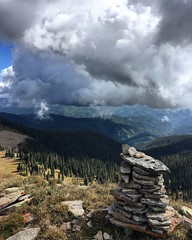One more week and I get to sleep in a tent for the first time this year – planning a weekend backpack in the North Pennines. Cant wait, will be interesting to see how hardy (or not) I am! Have not wild camped since last October.
In the meantime I thought I would write up a backpacking trip I did last summer with Corrina.
I have always wanted to visit Raasay, a long narrow Island located between Skye and Applecross on the mainland. A two week holiday in the highlands with Corrina gave me the perfect opportunity. We had agreed that if we stay in nice campsites with showers and stuff for most of the trip, then she would come on a two day backpack with me. We set off from Applecross over the Bealach na ba, probably the best road I have ever driven. The weather was amazing with views over to Skye from the summit of the road at 626m. I managed a quick bag of the Corbett Sgurr a Chaorachain, which is well worth doing as the views are to die for. We drove down and spent the night in Plockton which we wanted to visit as it is was the setting for Hamish Macbeth. Really did not like the place, all full of art galleries and expensive cars.
Left the next morning in appalling weather to drive over the Skye bridge. Skye looked pretty bleak and uninviting in the low cloud and rain from the A87, no mountains on view today! We got to sconser only to discover we had a 4 hour wait as it was a Sunday – off to the Sligachan hotel bar then! It appeared that the whole campsite across the way was sitting dripping in the bar, reading and looking glum.
Late afternoon and we were boarding the ferry with 2 other vehicles for the short crossing to Suisnish. It felt like we were heading off into the unknown as we drove off the ferry. Through the village of Inverarish then climbing up on the single track road past the youth hostel. The road surface soon turned pretty rough as it climbed over the 200m mark, with the wind battering us from the west. The views across to skye was awesome with the whole of the east coast in view.
Map of Raasay (click to enlarge)
We searched for ages for somewhere to park up for the night, but places were lacking that were not directly in the full force of the wind. We eventually found a spot that was relatively sheltered but decided not to put the roof up as some gusts were pretty ferocious. Did not want to loose the roof out here!
Bongo wild camp

Not that keen on parking up next to a road but we only had one vehicle pass us in the 12 hours we were there! The morning dawned bright, warm and sunny so we continued heading to the north of the Island. The last two miles of road are known as Callums Road after the local man who built it by hand. What a road it is! It is only just the width of the van and it twists and turns above cliffs with unprotected drops down into the sea.
Interesting road sign on Raasay

We did safely reach the end of the road at Arnish so shouldered our rucksacks and headed into the wild. The next few miles were probably one of the best low level walks I have done. The path was constantly twisting in and around rocky outcrops with stunning views at every step.
View to the north of Raasay with the Island of Rona in the distance

View across the Sound of Raasay to the east coast of Skye

After a few hours of gentle walking and lots of sitting down and taking in the views, we finally arrived at Taig Thormoid Dhuibh bothy which is maintained by the MBA (Mountain bothies association). The location of which was even better than we had imagined with 180 degree views to the sea. It has one open plan room with a fireplace at one end and a sleeping platform at the other. The major drawback is the lack of any firewood in the area. Determined to have at least a small fire in the evening, I left Corrina at the bothy for a couple of hours as I set off on a scavenge along the rocky shore. There was only the odd bit of driftwood to be found so if you are planning to come here in the colder months make sure you carry in some fuel. We spent the evening sitting outside the bothy watching the sun set over Skye. Even at midnight the sky was still tinged with pink and night was a bright twighlight.
Sitting outside Taig Thormoid Dhuibh bothy

Cooking in the bothy

Taig Thormoid Dhuibh looking towards the Isle of Skye

The next morning was spent lazing around the bothy before heading back the way we had come to the van. The weather broke just as we got back to the road head. Wind and rain with a curtain of mist hiding Skye.





